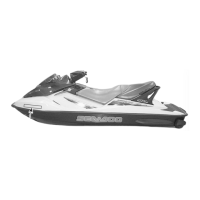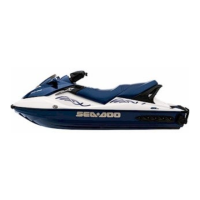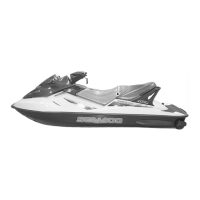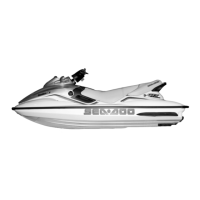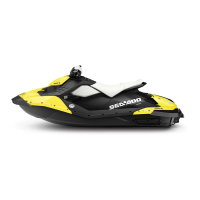Why my Sea-Doo Boat beeps every minute?
- CCindy DuarteSep 7, 2025
If the Sea-Doo boat is beeping every minute for 2 seconds, it may be upside down. Turn the watercraft upright.
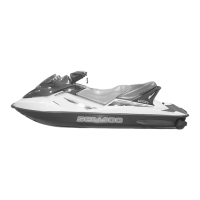
Why my Sea-Doo Boat beeps every minute?
If the Sea-Doo boat is beeping every minute for 2 seconds, it may be upside down. Turn the watercraft upright.
How to fix weak spark in Sea-Doo Boat?
If your Sea-Doo boat has a weak spark, replace the fouled, defective, or worn spark plugs.
Why my Sea-doo 4-TEC GTX beeps every 5 minutes?
If your Sea-Doo boat is beeping every 5 minutes for 2 seconds, refill the fuel tank if the fuel level is low.
What does it mean if Sea-doo 4-TEC GTX Boat beeps short then long?
If your Sea-Doo boat emits one short beep followed by one long beep, remove and reinstall the safety lanyard. This should take the ECM out of the onboard diagnostic mode.
What to do if Sea-doo 4-TEC GTX has water in fuel?
If your Sea-Doo boat has water in the fuel, siphon and replace the fuel.
| Engine Type | 4-TEC |
|---|---|
| Seating Capacity | 3 |
| Fuel Type | Gasoline |
| Displacement | 1494 cc |
| Fuel Capacity | 15.9 gallons |
| Manufacturer | Sea-Doo |
| Model | GTX |
| Type | Personal Watercraft |
| Engine | 4-TEC |
Overview of the Sea-Doo personal watercraft and the importance of safety.
Key safety checks and general guidelines before operating the watercraft.
Recommended protective clothing, gear, and pre-operation tasks.
Collision avoidance, safe riding practices, and watercraft maneuverability.
Understanding right-of-way, navigation systems, and specific rules.
Commonly used hand signals for waterskiing.
List of relevant websites for boating information.
Identifies the location of important labels on the watercraft.
Location for the watercraft's registration number.
Details on locating Hull Identification Number (H.I.N.) and Engine Identification Number (E.I.N.).
Explanation of the functions of various controls and instruments.
Step-by-step instructions for safely fueling the watercraft.
Specifications for recommended gasoline octane for engine types.
Recommended oil types and viscosity for engine lubrication.
Procedure for checking and maintaining the correct engine oil level.
Information on recommended coolant and filling procedures.
Checking the coolant level in the expansion tank.
Procedure for replacing engine coolant.
Recommendation for a dealer check after the first 10 hours of operation.
Explanation of how the watercraft's propulsion system works.
How to operate the shift lever for neutral and reverse modes.
Adjusting the jet pump nozzle for optimal riding attitude and performance.
How the handlebar controls watercraft direction and turning capabilities.
Functionality of the O.P.A.S. system for enhanced steering.
General precautions for boarding the watercraft safely.
Instructions for boarding from a dock or in shallow water conditions.
Procedures for boarding the watercraft in deep water.
Pre-start checks before unloading the watercraft.
Starting procedures for cold and warm engines.
Guidelines for safe watercraft operation at various speeds.
Specific precautions when operating with a wakeboard rack.
Operating advice for rough water or low visibility conditions.
Techniques for safely crossing waves.
Procedures for slowing down and docking the watercraft.
Instructions for safely bringing the watercraft to the beach.
Routine steps to care for the watercraft after operation.
Specific care procedures for operation in foul or salt water.
Procedure for flushing the exhaust cooling system.
Applying treatments to prevent corrosion on metallic parts.
Explanation of the engine management system's monitoring functions.
Understanding reduced performance modes for safe return.
Troubleshooting and procedures for engine overheating issues.
Addressing low engine oil pressure warnings and potential damage.
Cleaning procedures for the jet pump intake and impeller.
Procedure for handling a capsized watercraft.
Steps to take if the watercraft becomes submerged.
Actions to take if the engine is water-flooded.
Procedure for starting a fuel-flooded engine.
Precautions and procedures for towing the watercraft in water.
Information regarding low battery conditions.
Details on emission control systems and regulations.
General guidelines for watercraft maintenance and servicing.
Guidelines for regular watercraft servicing schedules.
Procedures for lubricating various parts of the watercraft.
Checking the throttle cable for smooth operation and free play.
Procedure for changing engine oil and replacing the oil filter.
Information on valve adjustment (not applicable for this engine).
Procedure for replacing the engine coolant.
Inspection of the fuel injection system.
Checking and adjusting the watercraft's steering alignment.
Adjusting the Variable Trim System for optimal performance.
Checking and cleaning the vacuum bailer pick-up screens.
Locating, identifying, and replacing fuses.
Guidelines and precautions for trailering the watercraft.
Procedures for safely launching and loading the watercraft.
Recommendations for storing the watercraft.
Cleaning and minor repair procedures for the watercraft body.
Applying treatments to prevent corrosion on metallic parts.
Protecting the drive shaft from corrosion.
Final checks and preparations before storage.
Steps for preparing the watercraft for the season.
Interpreting beep codes from the monitoring system.
Understanding messages displayed on the information center.
Diagnosing and resolving issues when the engine fails to start.
Troubleshooting steps for slow engine cranking.
Diagnosing normal engine operation issues.
Resolving issues with engine misfires or irregular running.
Diagnosing and resolving lean fuel mixture issues.
Troubleshooting high fuel consumption and rich mixtures.
Identifying causes and solutions for engine smoke.
Diagnosing and resolving engine overheating.
Addressing engine pinging or knocking sounds.
Troubleshooting engine performance issues.
Diagnosing why the watercraft is not reaching its top speed.
Resolving issues with decreasing engine RPM or engine stops.
Technical specifications for the watercraft engine.
Specifications for the watercraft's cooling system.
Specifications for the watercraft's electrical system.
Fuel system specifications, including recommended fuel types.
Specifications related to the watercraft's propulsion system.
Physical dimensions and capacity specifications.
Contact information for warranty service in North America.
Details the scope and coverage of the limited warranty.
Specifies the duration of the warranty coverage for different uses.
Requirements for obtaining warranty coverage.
Steps for obtaining warranty service.
Outlines BRP's responsibilities under the warranty.
Lists items and conditions not covered by the warranty.
Details limitations and disclaimers of liability.
Procedure for transferring warranty coverage to a new owner.
Contact information for consumer assistance and dispute resolution.
Explanation of the star rating system for cleaner marine engines.
Consumer rights and obligations regarding emission control warranty.
Details the emission warranty coverage for California models.
Defines the scope and duration of the international limited warranty.
Specifies warranty periods for private and commercial use.
Conditions required for warranty coverage validity.
Steps to follow to obtain warranty service.
Details BRP's warranty obligations.
Lists items and conditions excluded from warranty coverage.
States limitations on warranties and liability.
Procedure for transferring warranty to a new owner.
Contact information for consumer assistance.
